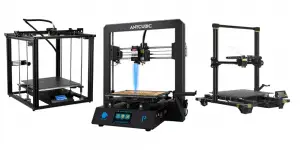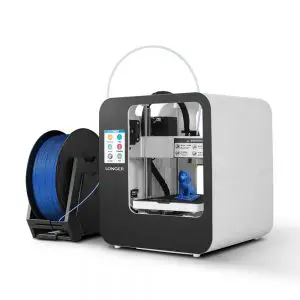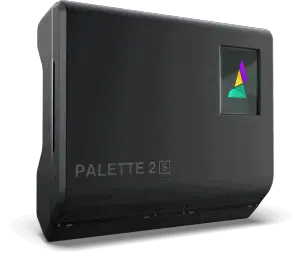What is SLA 3D Printing?
Stereolithography or SLA is the oldest form of 3D printing. It’s been used since the 1980s by sweeping a laser across a pool of resin, curing layer by layer until the build is complete. Every SLA 3D printer has the following basic components:
- Tank: The tank holds the liquid photopolymer which is normally a clear liquid plastic.
- Print bed: This is usually a perforated platform that gets immersed in the tank. Depending on the printer, this platform moves up and down out of the tank.
- Laser: A high powered ultraviolet laser cures every individual layer printed with the resin.
- Computer Interface: This controls the movement of the light source and the print bed. It allows the majority of SLA 3D printers to operate without being tethered to an actual computer.
Designs of SLA 3D printers
The lasers inside these printers will either sit below the tank of resin and point up, or they’re positioned above it and point downward. Mirror galvanometers move rapidly to deflect the laser beams to a specific spot in the resin. It’s similar to channeling sunlight through a magnifying glass pointing the beam of light off of a mirror to get it exactly where you want it to go. Once the laser finishes printing a layer, the platform moves away from the light so that the next layer can be cured in its specified design.
Pros & Cons of SLA printing
Pros
- This is the most precise type of 3D printing.
- Printing prototypes can be done with extremely detailed features, high quality, and complex geometrical shapes.
- It provides dimensional tolerances that are tighter than the majority of rapid prototyping.
- Print surfaces are smooth and don’t require much sanding or cutting after the build is complete.
- The builds can be as large as 50 cm x 50 cm x 60 cm without degrading the precision of the design.
Cons
- Very long print times.
- The steeper your slopes and any necessary overhangs will require supports that can collapse or warp during the build process.
- You’re very limited in your materials and color choices for resins.
- Many of the resins belong to the companies that specifically design them to be compatible with their 3D printers which prevent many of them from being interchangeable.
- The costs can be high which includes both the expense for resins and maintenance.
What is DLP 3D Printing?
If you’re looking at the letters in DLP wondering where you’ve seen them before, it’s because the very same technology is used in televisions and projectors. Digital light processing in a 3D printer uses a projector screen to flash an entire layer across the platform while the light source cures every pixel, voxel after it’s translated to 3D, simultaneously. A digital micromirror device, DMD, directs light and creates the pattern of the layer onto the bottom of the resin vat.
Pros & Cons of DLP printing
Pros
- Printing and curing entire layers at once speeds up build times.
- Since the light source used is not a laser isn’t as costly to maintain or replace.
Cons
- Larger print volumes aren’t easy as the pixels/voxels aren’t easily read in larger scales
- Because the voxels are rectangular in nature, the finish of the build won’t be as smooth as SLA builds
DLP vs SLA: What’s the Difference?
There will be a variety of characteristics that make SLA comparable to DLP printing, as well as a few that will make them differ. Overall, it will depend on your needs that should determine which is better for your build.
Similarities Between SLA and DLP
- Both SLA and DLP use light to cure a photosensitive resin.
- Both processes produce builds that operate like injection-molded parts.
The differences between the two are a bit more extensive.
Differences Between SLA and DLP
- DLP printers are less expensive with prices averaging between $400 – $1000, while SLA printers carry a huskier price tag averaging between $3000 – $4000. However, both have high-end models that can run over $10,000.
- SLA printers require professionals to intervene if any of the lasers or optics need to be replaced or repaired which will often require you to send the printer back to its manufacturer. Hopefully, it’s within the warranty period should anything like that happen to prevent the costs from climbing any higher. DLP printers use simpler components which can be better managed by the printer’s owner.
- SLA requires a longer post-curing process, and it requires a longer build time as well where a 30-minute build on a DLP printer can take up to 4 hours with SLA.
More Important Facts About DLP vs SLA
- The resins aren’t interchangeable because of the curing and exposure time differences between SLA and DLP printers.
- Make sure to submerge your builds in isopropyl alcohol to remove excess resin, but also post-cure them in UV ovens, similar to a UV lamp used in a manicure shop.
- DLP printers are thought to be less likely to malfunction because of their components aren’t as complex as SLA printers.
How Does SLA 3D Printing Compare to FDM Printing?
FDM filaments are passed through hot extruders, layer by layer until the build is complete. Here are a few of the properties filaments can be combined with:
- Wood
- Biological
- Metal
- Carbon-fiber
FDM’s resolution also depends on how accurate and fast the motors move along with the diameter of the extruder to create detailed builds while SLA uses the tightness of its laser beams.
- Post-printing – FDM only requires you to remove any supports and maybe some sanding to smooth the surface.
- Adhesion – FDM objects can be removed easily and if they get stuck you can use a palette knife to remove the build from the print bed. If there’s too much resin left on the platform, the build can be difficult to remove without marring the finished project.
- Costs – FDM nozzles and filament rolls need to be replaced fairly often but they’re economical. However, the resin tanks in SLA printers need replacing after 2-3 liters of use because the tank gets smudged and stops the light source from projecting the image in the resin clearly. Also, the moving platform needs to be replaced after it gets marred from removing SLA builds. The resin isn’t cheap either.
SLA vs DLP: Which to choose?
If you’re looking for speed with precisely detailed builds where strength isn’t your biggest concern, DLP will be the better option. Its printers are more cost-effective than SLA and require less outside maintenance.
SLA printing is great if you have the time because you’ll get a very smooth finished surface with intricate details. Remember that the post-print curing process will be longer than DLP as well.
Both processes take longer than FDM, but for the purpose of building an army of small detailed figurines, you’re better off using a DLP printer to get you what you need in a timely fashion.




